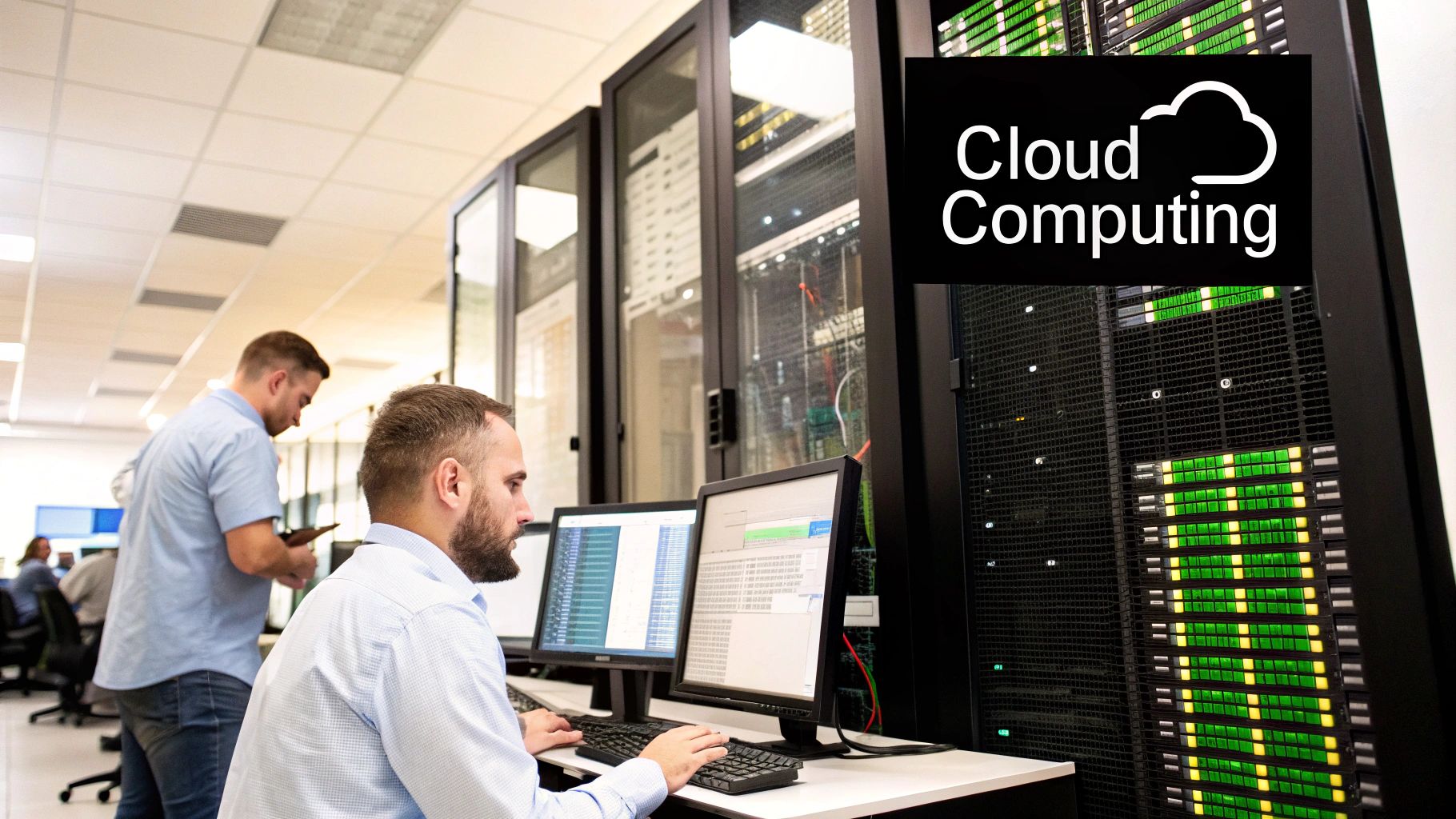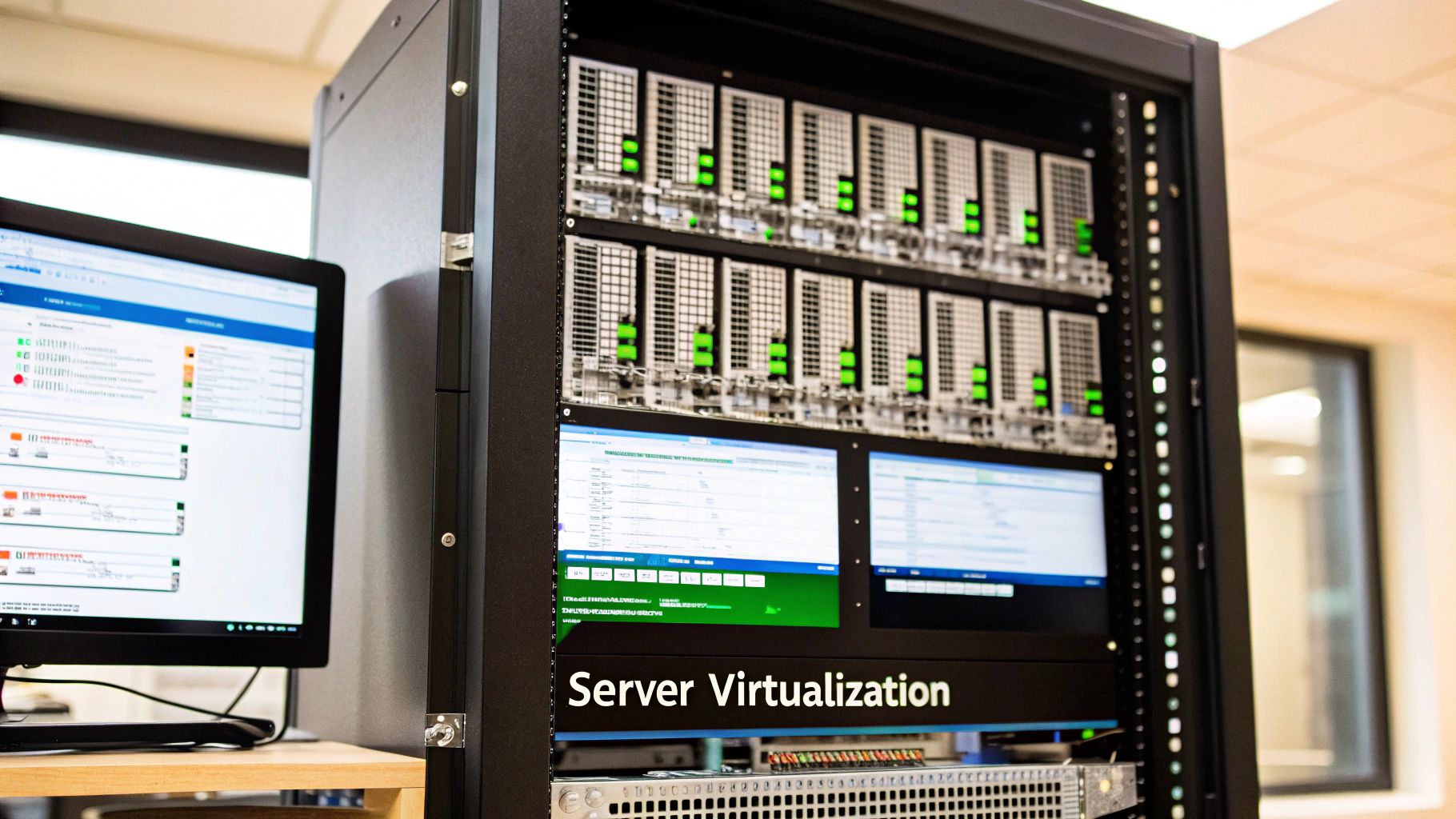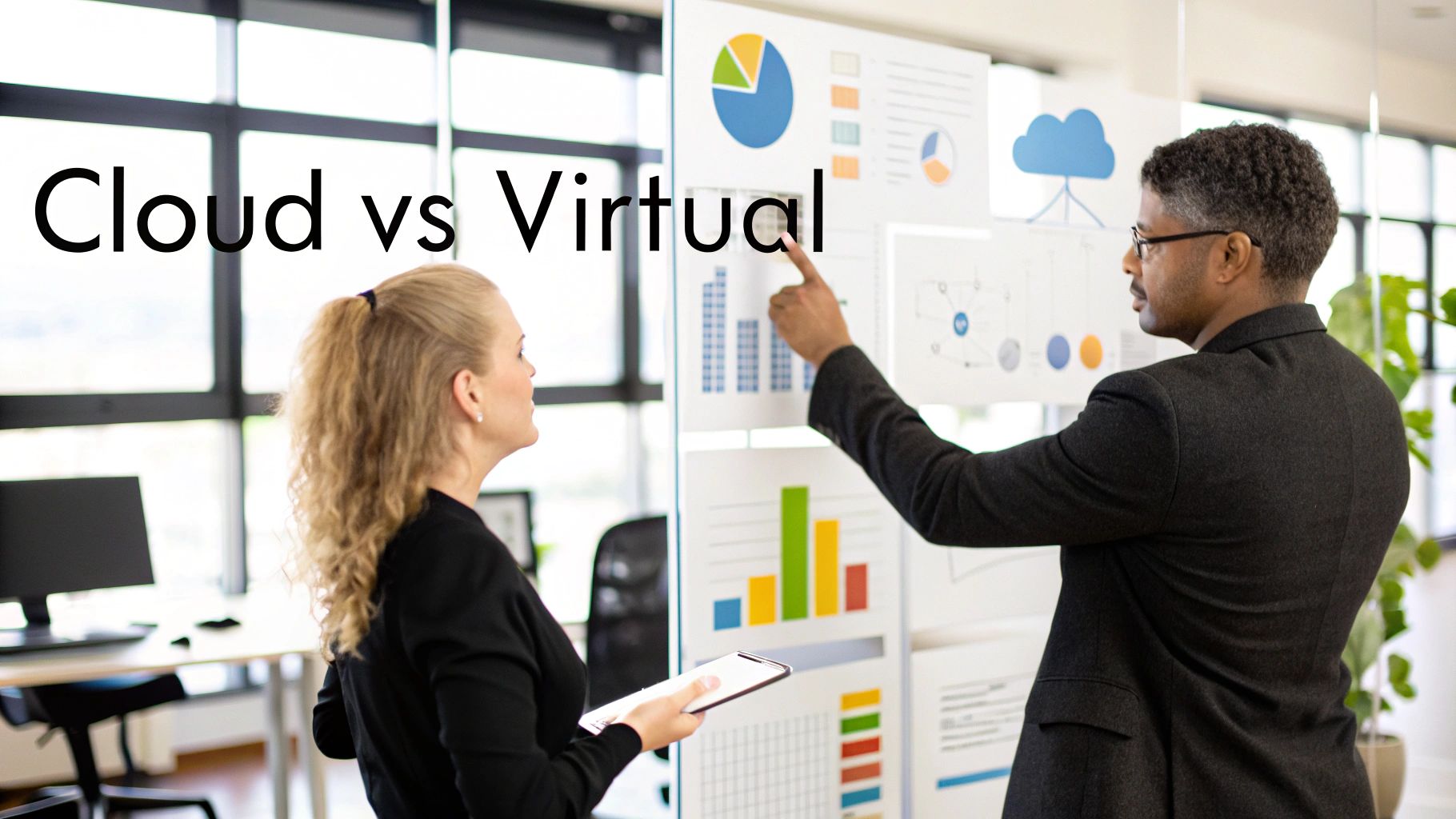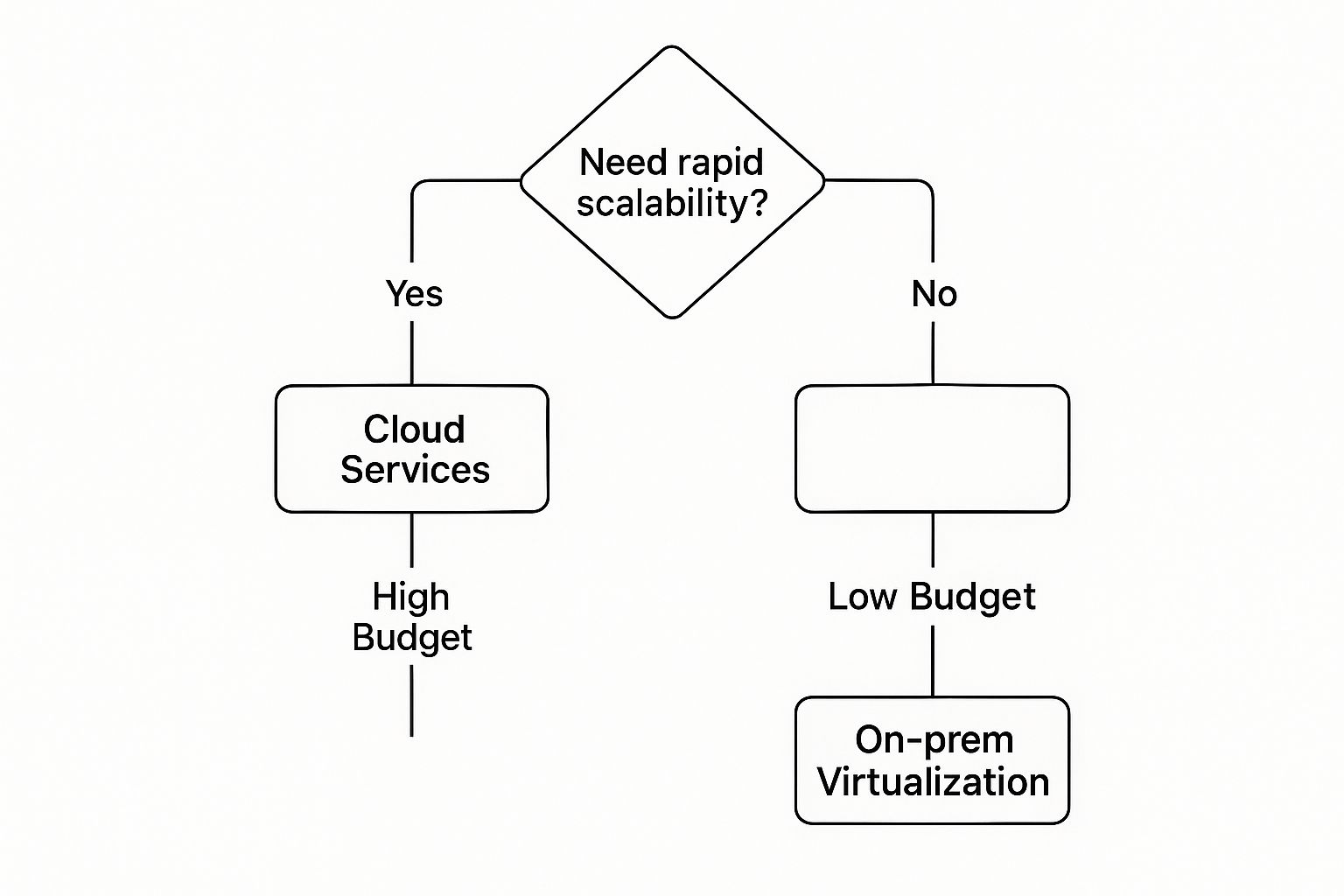Understanding Cloud And Virtualization Beyond The Hype

To make sound infrastructure decisions, it’s vital to look past the marketing language that often merges cloud computing and virtualization. While vendors might intentionally blur the lines, these two concepts are fundamentally different approaches to information technology. A clear grasp of the difference between cloud and virtualization is the first step toward creating an infrastructure that supports organisational goals, rather than just following industry trends.
Deconstructing The Core Concepts
At its foundation, virtualization is a core technology. It is the method of creating a virtual representation of a physical asset, like a server, storage device, or network. This is accomplished with software known as a hypervisor, which divides a single physical machine into multiple, isolated virtual environments. Imagine this as partitioning a large building into separate, self-sufficient apartments. Each apartment (a virtual machine) can be set up for its resident (an application) but still relies on the building’s main structure and utilities (the physical hardware).
On the other hand, cloud computing is a service delivery model that uses virtualization, but its application is much wider. It offers a complete ecosystem for accessing computing resources from servers and storage to databases and machine learning tools on an on-demand basis over the internet. Using our building comparison, cloud computing isn’t just the apartments; it’s the entire managed property service. This includes the building itself, security, maintenance, utilities, and a reception that can instantly give you more or less space as your needs change. This service-focused approach is a key distinction.
The Synergistic Relationship
It is a frequent mistake to see this as a choice between one or the other. The reality is that virtualization is the powerful engine that enables modern cloud computing. Cloud providers apply virtualization at a massive scale to efficiently run their extensive data centres, partitioning powerful physical servers to accommodate millions of customers. However, the cloud builds critical layers on top of this base:
- Automation and Orchestration: Cloud platforms automate the setup, scaling, and management of resources.
- Self-Service: Users can access resources on their own through a web portal or API, without needing manual help from an IT team.
- Pay-as-you-go Billing: Costs are tied directly to usage, shifting IT spending from a capital expense to an operational one.
In business settings, these concepts have distinct yet related roles. For example, in India, cloud computing and virtualization are often linked but perform different jobs in digital infrastructure. The cloud acts as a broad service delivery model, while virtualization focuses on abstracting resources. You can explore more about India’s public cloud market trends to see this relationship in practice.
Architecture Deep Dive: Why Design Choices Matter
The architectural blueprints of virtualisation and cloud computing reveal the core distinction between the two, explaining why each is suited for specific scenarios. Understanding these foundational designs is critical for creating an IT infrastructure that is not just functional but also strategically aligned with your business goals.
Virtualisation: The Architecture of Direct Control
Virtualisation architecture centres around the hypervisor, a software layer that acts as an intermediary between the physical hardware and the virtual machines (VMs). You can think of the hypervisor as a dedicated building manager for a single, powerful server. It partitions the server’s resources CPU, memory, storage and allocates them to create multiple, isolated virtual environments.
This structure provides an organisation with direct, granular control. Your IT team functions as the architect, determining exactly how many resources each VM gets, setting up network paths, and applying security policies directly on the infrastructure you own and manage. This architecture is perfect for situations where predictable performance and complete oversight are essential, such as running legacy applications with specific hardware needs or complying with strict data residency regulations. 66% of businesses report improved agility from virtualisation because of this direct management capability.
Cloud Computing: The Architecture of Distributed Services
Cloud architecture employs a fundamentally different model. Instead of concentrating on a single physical host, it functions on a massive, distributed scale. Cloud providers use virtualisation, but they integrate it into a complex network of automation and orchestration systems spread across global data centres. This isn’t just one building manager; it’s a global real estate company managing millions of properties at once.
This distributed design enables the cloud’s defining features:
- Automated Scaling: Advanced management planes monitor resource usage across the entire platform and automatically assign or release resources to meet fluctuating demand.
- High Availability: Workloads are not confined to a single physical machine. If one server fails, orchestration systems seamlessly shift the workload to healthy hardware, often without any noticeable downtime for the end-user.
- Service Abstraction: The underlying complexity of the hardware and virtualisation is hidden from the user. Instead, they interact with a simple self-service portal or API to access resources like a utility.
This architecture is most effective when you require geographic reach, resilience, and the capacity to manage unpredictable demand without manual intervention. It exchanges the direct control of virtualisation for the convenience and scale of a managed, globally-distributed service.
To better illustrate these differences, the table below explores how each architectural approach affects key organisational factors, from capital investment to operational complexity.
Architectural Components: Cloud vs Virtualisation Impact
How different architectural approaches affect real-world implementation complexity and organisational control
| Architecture Layer | Virtualisation Control | Cloud Computing Model | Business Impact |
|---|---|---|---|
| Hardware Management | The organisation procures, manages, and maintains all physical servers and networking equipment. | The provider owns and manages all hardware; the customer has no physical access or responsibility. | Virtualisation requires significant capital expenditure (CapEx) and specialised in-house expertise. Cloud converts this to an operational expense (OpEx). |
| Resource Allocation | Manually configured by administrators via the hypervisor management console. | Automated and programmatic, driven by user-defined policies or real-time demand. | Cloud offers superior elasticity for variable workloads, whereas virtualisation provides predictable resource assignment for stable applications. |
| Fault Tolerance | Requires manual setup of failover clusters and redundant hardware within a single data centre. | Built-in at the platform level, often spanning multiple geographic regions for robust disaster recovery. | Cloud providers deliver a higher baseline of resilience, which would be expensive and complex to replicate on-premises. |
| Security | Full control and responsibility for the entire security stack, from physical access to the operating system. | A shared responsibility model where the provider secures the infrastructure, and the customer secures their data and applications. | Virtualisation offers complete security sovereignty. Cloud provides access to advanced, scalable security tools that might be too costly for individual companies. |
Ultimately, the choice hinges on control versus convenience. Virtualisation gives you the keys to the entire building, allowing for precise customisation but demanding full responsibility for maintenance. Cloud computing offers a fully serviced apartment in a global complex, providing robust amenities and resilience at the cost of direct control over the underlying infrastructure.
Service Delivery Models That Actually Work

The most significant operational difference between cloud and virtualization is rooted in how they deliver resources and value to an organisation. Virtualisation usually operates as an internal, self-managed utility. In this scenario, your IT department functions as a private service provider, handling the provisioning of virtual machines, resource allocation, and all maintenance tasks. This approach offers complete control over the environment, making it suitable for predictable workloads and applications with strict compliance or data sovereignty needs. You are essentially running your own private cloud, but with the entire management responsibility on your shoulders.
Cloud computing changes this dynamic by delivering value through specific service models that abstract away various layers of technical complexity. This service-focused approach alters how your teams engage with technology, shifting their focus from managing infrastructure to consuming services.
Choosing Your Level of Abstraction
The three main cloud service models present a different balance of control and convenience. This allows you to pick the model that best aligns with your technical skills and business objectives.
- Infrastructure as a Service (IaaS): This model most closely resembles traditional on-premises virtualisation. The cloud provider manages the physical infrastructure servers, storage, and networking while you remain responsible for the operating system, applications, and data. It is like leasing a fully equipped, empty commercial kitchen; you determine the menu, supply the ingredients, and manage the cooking, but you are not responsible for maintaining the ovens or plumbing. The flexibility of this model makes it extremely popular. The growth in India’s public cloud market, which is projected to reach approximately US$15.37 billion in 2025, is primarily driven by the IaaS segment. You can read more about the Indian cloud market’s exponential growth at CRNasia.com.
- Platform as a Service (PaaS): PaaS takes abstraction a step further. The provider manages the hardware, operating systems, and the entire runtime environment. This arrangement allows your developers to concentrate exclusively on writing and deploying application code without needing to manage the underlying infrastructure. Consider it a meal-kit delivery service; the ingredients and recipe are supplied, so you can focus on the creative part of cooking without the need for shopping or preparation.
- Software as a Service (SaaS): As the most abstracted model, SaaS delivers complete, ready-to-use applications directly over the internet. You simply subscribe and use the software without any infrastructure management concerns. This is comparable to dining at a restaurant; you enjoy the finished meal with no part in its preparation.
A clear understanding of these delivery models is essential for making an informed decision. The choice between IaaS, PaaS, or SaaS is heavily dependent on your unique requirements, and a detailed cloud provider comparison can help identify which platform best suits your goals. The key is to match the service delivery model with your organisation’s capabilities, control requirements, and strategic objectives.
Real Cost Analysis Beyond The Marketing Numbers
To truly understand the financial implications of your infrastructure choices, you must look past the vendor pricing sheets. The real economic difference between cloud and virtualisation becomes clear only when you calculate the total impact over a realistic timeframe, not just the initial price tag. A surface-level comparison can be misleading, as both models have hidden expenses and long-term financial consequences.
The Upfront Costs and Predictability of Virtualisation
Virtualisation generally aligns with a traditional capital expenditure (CapEx) model. This approach requires a considerable upfront investment in physical hardware, such as servers and networking equipment, along with software licences for the hypervisor and management platforms. It also demands a budget for skilled personnel to design, implement, and maintain the on-premises infrastructure.
While the initial investment is significant, this model provides a high level of cost certainty. Once the infrastructure is running, ongoing expenses for maintenance, power, and cooling are typically predictable. However, this predictability relies on precise capacity planning. Under-provisioning can lead to performance issues that impact the business, whereas over-provisioning means you’ve paid for expensive hardware that sits unused—a frequent problem for organisations with fluctuating workloads.
The Operational Costs and Governance of Cloud Computing
Cloud computing shifts the financial model from CapEx to operational expenditure (OpEx). It works on a variable, pay-as-you-go basis that directly links costs to actual resource usage. This allows organisations to scale their spending in line with business activity, avoiding the risk of investing in underutilised hardware. For startups and businesses facing unpredictable growth, this is a significant benefit.
This flexibility, however, introduces its own financial risks. Without strict governance, monitoring, and optimisation, cloud costs can grow unexpectedly. The phenomenon of “cloud sticker shock” is a common issue for teams that fail to manage usage spikes or forget to decommission unused resources. Other hidden costs can also emerge from:
- Data Egress Fees: Charges for transferring data out of the cloud environment.
- Staff Retraining: The investment needed to equip your team with cloud-specific skills.
- Migration Expenses: The cost and effort involved in moving applications to the cloud.
To frame a more complete total cost of ownership (TCO) analysis, it’s helpful to see how these financial models compare in practical scenarios. The following table breaks down the costs you can expect over a five-year period.
Five-Year Financial Impact: Cloud vs Virtualisation Scenarios
Real-world cost analysis showing total investment requirements for different organisational contexts
| Investment Category | Virtualisation Path | Cloud Computing Path | Decision Factors |
|---|---|---|---|
| Initial Investment | High (hardware, licences, setup labour) | Low to None | Do you have available capital or prefer operational expenses? |
| Ongoing Costs | Predictable (power, cooling, maintenance) | Variable (pay-per-use, potential for spikes) | Does your workload fluctuate, or is it stable and predictable? |
| Personnel Costs | High (specialised IT staff for hardware management) | Lower (focus shifts to cloud governance and optimisation) | Is your IT team focused on infrastructure management or business innovation? |
| Scalability Costs | High and Slow (requires purchasing new hardware) | Low and Instant (pay for additional resources as needed) | How quickly does your business need to respond to changes in demand? |
Ultimately, the choice hinges on your organisation’s financial strategy and operational needs. A virtualisation path offers budget predictability for stable environments, while a cloud path provides the financial agility needed to adapt to dynamic market conditions. A thorough analysis of these factors is essential to making a sound long-term decision.
Scalability Strategies That Match Your Business Reality

Scalability is where the most significant difference between cloud and virtualisation becomes apparent, with direct consequences for performance and cost. The approach you select must align with your organisation’s demand patterns; a mismatch can lead to either squandered resources or lost opportunities. Understanding how each technology addresses growth is crucial for building a resilient and financially sound infrastructure.
The Planned Growth of Virtualisation
Scaling within a virtualised environment is a deliberate and manual undertaking. This method, often called vertical scaling, involves adding more resources like CPU and RAM to existing physical servers. Once those servers hit their physical capacity, horizontal scaling becomes necessary, which means buying, installing, and setting up new hardware. This cycle requires considerable advance planning, procurement lead times, and manual resource allocation by your IT team.
This structured process is well-suited for businesses with predictable, steady growth. A company that hires a specific number of new employees each quarter can accurately forecast its server requirements and schedule hardware acquisitions. The predictability offers stable performance and control over the budget. However, this model is not designed for sudden, unexpected demand. An e-commerce site expecting a flash sale, for example, cannot afford to wait weeks for new hardware to be provisioned to manage a massive traffic increase.
The On-Demand Elasticity of the Cloud
Cloud computing operates on the principle of elasticity, a much more dynamic form of scalability. Instead of manually adding resources, cloud platforms can be set up to automatically scale up or down based on real-time data like CPU usage or network activity. When an application sees a jump in demand, the cloud automatically provides more virtual machines or container instances to handle the load. Critically, when demand drops, those extra resources are automatically removed, and you stop paying for them.
This on-demand model is ideal for businesses with fluctuating or seasonal workloads.
- Retail and E-commerce: Manages huge traffic increases during festival seasons or major sales events like Diwali or Black Friday.
- Media and Entertainment: Scales rendering farms for large-scale projects and then reduces them once the work is complete.
- Data Analytics: Provisions powerful computing clusters for intensive, short-term data processing jobs and then shuts them down.
This elasticity ensures that performance is maintained during peak times without the financial weight of owning and maintaining hardware that is often idle. The capability to respond to market shifts in minutes, rather than weeks, delivers a notable competitive advantage.
Finding the Right Fit for Your Workload
The decision is not about which scaling method is superior in theory, but which one aligns with your application’s specific needs. For stable, essential applications with foreseeable resource requirements, the controlled scaling of virtualisation provides reliability and cost management. For dynamic, customer-facing applications where demand is uncertain, the elasticity of the cloud is indispensable.
Many organisations discover value in a hybrid model. They use on-premises virtualisation to support their baseline, predictable workloads, ensuring cost control and stability. For variable or “bursty” workloads, they extend into the public cloud, gaining the agility to handle peaks without over-investing in their own data centre. This strategic combination aligns technology directly with business needs, optimising both cost and performance.
Security And Compliance: Control vs Convenience
When weighing the **difference between cloud and virtualization**, security and compliance are critical factors. The decision often comes down to a trade-off between the direct control offered by virtualization and the managed convenience of the cloud. Your choice here will define your risk management strategy, shape your data governance policies, and determine your ability to satisfy regulatory requirements.
Each model presents specific security advantages and responsibilities. These must align with your organisation’s internal skills, resources, and overall risk tolerance. Let’s break down what this means in practice.
Virtualisation: The Framework of Absolute Control
With virtualisation, the responsibility for security and compliance rests entirely with your organisation. You own the physical hardware, you manage the hypervisor, and you are accountable for every layer of the technology stack. For businesses in highly regulated industries or those with very specific security needs, this absolute control is a primary benefit.
The key advantages of this self-managed approach include:
- Complete Data Oversight: You have direct physical and logical command over where your data is stored. This is often a non-negotiable requirement for meeting certain compliance mandates.
- Custom Security Policies: You can design and deploy bespoke security setups, from firewalls to intrusion detection systems, that are perfectly matched to your application’s needs.
- Air-Gapped Systems: For the highest level of security, virtualised environments can be completely cut off from public networks. These “air-gapped” systems are protected from external online threats.
However, this level of control brings with it the significant task of implementing, managing, and constantly updating every security measure. Your team must have the expertise to defend against new threats and perform regular audits to maintain compliance, which can be a resource-heavy commitment.
Cloud Computing: The Shared Responsibility Model
Cloud computing operates on a shared responsibility model, which reallocates security duties. The cloud provider secures the underlying infrastructure the data centres, physical servers, and core network. As the customer, you are responsible for securing everything you place on the cloud, such as your data, applications, identity and access management (IAM), and network configurations.
This division of labour means you benefit from the provider’s substantial investment in security infrastructure and specialised personnel. Cloud platforms provide advanced tools for automated threat detection, sophisticated IAM systems, and continuous compliance monitoring that are often financially out of reach for individual companies. A detailed cloud security assessment is vital for understanding and correctly configuring these tools to safeguard your assets.
This shared model has important nuances, especially in regions with strict data legislation. For example, a key point of comparison between cloud and virtualisation in the Indian context is the strong focus on regulatory compliance and data sovereignty. As detailed in a report on Indian cloud adoption trends on DQIndia.com, these concerns have influenced how cloud services are delivered, leading providers to offer region-specific solutions.
The question isn’t which option is inherently more secure. Instead, you must determine which security framework best aligns with your organisation’s structure, in-house expertise, and specific compliance duties.
Strategic Decision Framework For Your Organisation
Choosing the right infrastructure requires a systematic evaluation that looks past vendor presentations and industry excitement. A clear framework helps align technology decisions with actual business objectives. This process involves a careful examination of your organisation’s current state, future goals, and operational realities, ensuring your choice supports growth rather than just following trends. The core of this analysis is understanding when to use cloud services, when virtualisation is more suitable, and how to combine both effectively.
Assessing Your Workload and Growth Trajectory
The first step is a detailed analysis of your application workloads and expected growth. Not all applications are the same, and their unique characteristics heavily influence the best environment for them.
- Workload Predictability: Do your applications, such as internal administrative software, have stable and predictable resource needs? If so, the controlled environment of on-premises virtualisation offers cost certainty and consistent performance.
- Demand Fluctuation: Do you manage applications with variable traffic, like an e-commerce platform or a data analytics service? The elasticity of cloud computing is designed for this, letting you scale resources up and down automatically to meet demand without over-provisioning.
- Performance Requirements: Are there critical applications that need ultra-low latency and dedicated resources? Virtualisation gives you direct control over the hardware, which can be essential for these specific performance guarantees.
The following infographic offers a decision tree to help visualise this choice based on key business factors like scalability and budget.

This decision tree illustrates that a need for rapid scaling points directly to cloud services, whereas budget limitations might favour on-premises virtualisation.
Factoring in Compliance, Skills, and Long-Term Vision
Beyond technical performance, strategic factors like regulatory requirements and internal capabilities are vital. For organisations handling sensitive data, the complete control offered by virtualisation might be necessary to meet strict compliance mandates. However, this control comes with the responsibility of managing the entire infrastructure, which demands a skilled IT team.
Conversely, moving to cloud services often means a shift in team skills from hardware management to cloud governance and cost optimisation. Your long-term vision also has a role. India’s cloud computing market, valued at approximately USD 29.50 billion, is expected to reach USD 232.78 billion by 2033, with a compound annual growth rate of about 25.80%. This growth suggests that cloud skills will become increasingly important. You can find more details in the public cloud forecast for India at Statista.com.
Ultimately, many organisations discover that a hybrid strategy is the most effective. This approach uses on-premises virtualisation for stable, core workloads while using the cloud for dynamic, customer-facing applications. Building a successful infrastructure requires a clear plan, and our guide on creating a cloud adoption framework provides structured steps for this process.
Ready to build an infrastructure that supports your business growth? At Signiance Technologies, we design and implement cloud and DevOps solutions that align with your strategic goals. Contact us today to optimise your performance and cost-efficiency.
